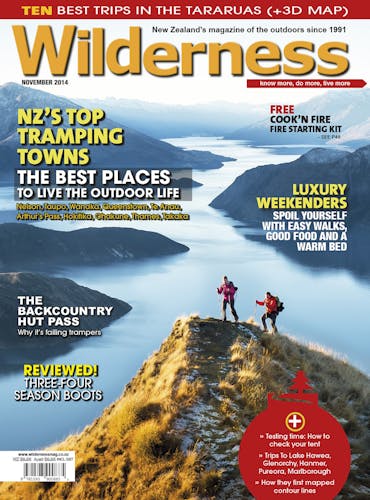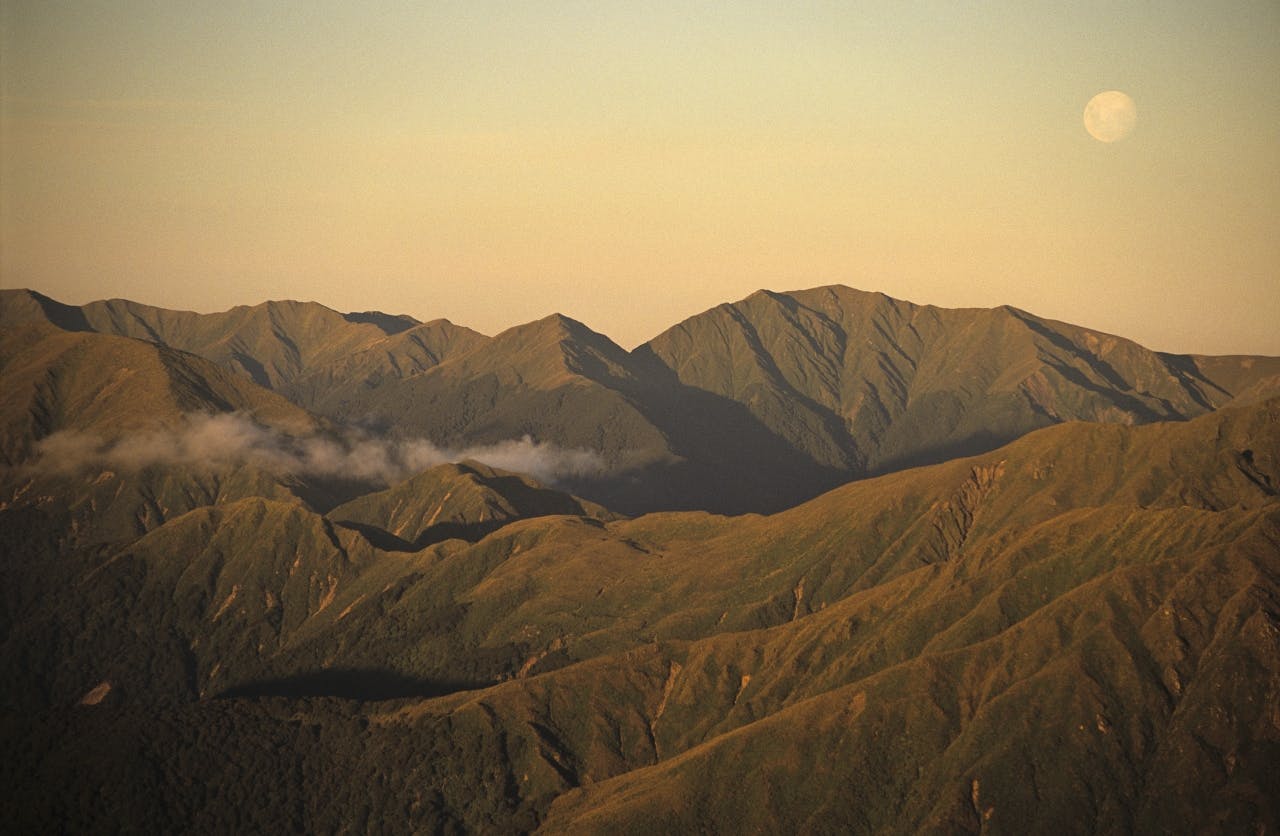The Tararua Range has a peculiar beauty that is hard to define. It’s something to do with the complex range of textures resulting from the particular blend of tussock, sub-alpine plants (notably leatherwood) and the distinctive pattern of crumpled, rolling tops. The range has fewer scree slopes and less bare rock than its more northerly counterparts, the rawer Ruahine and Kaweka Ranges, which softens its appearance too. And, instead of the mountain beech that dominates those other ranges, the Tararua Main Range boasts exquisitely mossy silver beech forest, stunted into fantastically twisted shapes at the bushline.
As a student, I spent many challenging and sometimes miserable days on the Tararua tops, battling wind, cold and fog, for which they are justly infamous. Only after shifting to Wellington did I begin to plan my Tararua trips around fine weather, and what a difference that made. The great allure of the range perhaps hit me most forcefully one evening at Bridge Peak, near Kime Hut, when the low westering sun illuminated a large swathe of tops. A pale moon rose in the east, and the complex patterns of the ridges was highlighted by the unusual coppery light. It was an evening to remember.
According to Tararua expert John Rhodes, trampers have different definitions of what constitutes the ‘Main Range’. Many, wanting to ‘do’ it in a weekend, consider it spans only between Bridge Peak and Junction Knob. However, as John points out, the watershed that divides rivers flowing west from those that flow east, actually stretches between Arete in the north and as far south as Aston, on the Southern Crossing. So, for the purposes of this profile, I’ve taken that broadest interpretation of the Main Range.
This section of tops encompasses several of the forest park’s major summits, but not the highest peak, Mitre. The Te Araroa Trail traverses much of the Main Range too. Certainly there’s enough terrain, both tracked and wilderness, to occupy a keen tramper for many months, with a good amount of shelter en route.
1. Arete and Arete Hut
At 1505m, Arete is one of the highest peaks in the forest park, and of Main Range mountains, second only to Mt Hector. It forms a junction, with Dundas Ridge branching off to the north, the Twins and Bannister tops to the east, and Pukematawai to the west. Several Tararua rivers have their headwaters here, from where they flow to all points of the compass. The 2-bunk Arete Hut built in 2007 (the second on this site) occupies a pleasant tussock ledge overlooking the Arete Valley.
2. Dracophyllum Knob and Hut
South of Pukematawai, the Main Range lies between 1000 and 1200m, just below the natural bushline. Apart from a few knolls, silver beech forest dominates this section of the range for several kilometers, with Dracophyllum Hut halfway along.
3. Nichols Hut
The 6-bunk Nichols Hut is perched on the south side of a peak bearing the same name, and forms a convenient shelter for those tackling a traverse of the range.
4. Junction Knob and Anderson Memorial Hut
Junction Knob is the point where the track down to Waitewaewae Hut branches off the Main Range. Further south lies Anderson Memorial Hut. The original hut, built in 1946, was named after the pilot who airdropped the materials onto site, but later died. It was later replaced with the existing hut, built by the Forest Service.
5. Aokaparangi and Aokaparangi Hut
Aokaparangi is a large dome of a peak, cast like an island between two sections of bush-clad ridges. Aokaparangi Hut is a modern, DOC-built 2-bunk hut, considerably more comfortable than the old dogbox biv that it superceded.
6. Maungahuka Hut
Arguably the best-sited hut in the Tararua Range, this DOC-built hut replaced an earlier Forest Service six-bunker. Situated near a sizeable tarn, with views north along the Main Range and as far away as Mt Taranaki, it’s a grand spot on a good day, but bleak when Huey decides otherwise.
7. The Tararua Peaks
Perhaps the most spectacular part of the range are the twin peaks, Tuiti and Tunui, known collectively as the Tararua Peaks. In the 1930s, pioneering trampers took several attempts to forge a route through this steep terrain, which required the use of a rope. Later trampers installed a wire cable, which in turn was replaced with a chain ladder by the Forest Service. DOC installed a more substantial aluminium ladder, which is steep enough to still ensure some excitement on the descent.
8. Kime Hut
The DOC-built Kime Hut III replaced two predecessors, both built by the Tararua Tramping Club. The new hut is a well-insulated, double-glazed design, but even then, the notorious Tararua weather caused a few water-proofing problems at first. It was officially opened this year.
9. Mt Hector
When tackling a Southern Crossing, trampers traverse over Mt Hector, the highest point on the Main Range. But it makes a good destination in its own right. It was presumably named after prominent nineteenth century scientist Sir James Hector, but John Rhodes tells me there is no direct evidence of this. The summit cross, erected by the Tararua Tramping Club, commemorates trampers who died in the Second World War.
10. Aston
At 1376m Aston is no giant, but the summit forms the apex of the so-called Dress Circle of the Southern Crossing. Rivers to the south of here flow into the Hutt catchment, but the peak is also part of the Waiotauru watershed, which flows into the Otaki River then west to the Tasman Sea. So, by definition, trampers heading for Alpha Hut leave the Main Range here at Aston.








